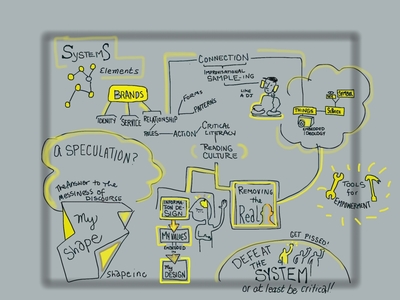Designing systems for praxis and critical engagement in design education: the speculative design method and the revelation of theory
Schaffzin, Gabriel and Kaiser, Zachary (2013) Designing systems for praxis and critical engagement in design education: the speculative design method and the revelation of theory. In: Relating Systems Thinking and Design 2013 Symposium Proceedings, 9-11 Oct 2013, Oslo, Norway.
Preview |
Text
Kaiser_Praxis_2013.pdf Download (651kB) | Preview |
![Schaffzin_MindMap_2013.jpg [thumbnail of Schaffzin_MindMap_2013.jpg]](https://openresearch.ocadu.ca/2163/2.hassmallThumbnailVersion/Schaffzin_MindMap_2013.jpg)  Preview |
Image
Schaffzin_MindMap_2013.jpg Download (274kB) | Preview |
Preview |
Text
rsd2kaiserschaffzin-131208092913-phpapp01.pdf Download (13MB) | Preview |
Abstract
To design systems that encourage learners to think systematically and consider the systems that exert power over their lives and the lives of others is to imbue them with the ability to free themselves from those powers. This paper seeks to present the perspectives of design educators working on implementing critical systemic thinking, hopefully inspiring awareness through practice and discourse in the domain of speculative and experimental design.
“Whenever we need a revolution,” writes Neil Postman as he paraphrases Lawrence Cremin in Technopoly: The Surrender of Culture to Technology, “we get a new curriculum.” The design of learning experiences, whether for high school history classes, undergraduate design classes, or online learning communities, is the design of systems. The practice of designing learning technologies is also a practice of system design.Within the design of every system is embedded a particular ideology. Whether few or many, designers, writers, administrators, policy-makers, and other individuals and groups of people establish the systems that shape our lives. Acting on the authorship of these systems are personal and cultural forces that shape how the systems are designed and understood.Possibly the most important ideology that we can embed within the design of contemporary learning systems is that of critical discourse through praxis: a tangible criticality. The creation of this tangible criticality can be thought of as a visualization of a system: a way to see and understand the systems that influence our thinking. We facilitate the creation of artifacts and experiences that function as a part of larger systems. These artifacts include products, websites, maps, books, prototypes, and proposals for technologies or experiences that may not yet be able to exist, all the while co-opting the language of the mainstream—one that is, today, based on the same values as the forces of the technologies upon which they act: objectivity, fact, proof, benefit, and other seemingly “neutral” concepts.
To be certain, this language does not exist in a vacuum. Rather, it is propagated through the channels and media with which producers sell their wares—product packaging, marketing materials, sales pitches, advertisements, and, most importantly, the programming of the product itself (be it analog or digital). At the helm of these channels sits the designer, trained to question critically the situation in order to design a final product or campaign that best addresses the needs of those seeking her expertise. As well intentioned or conscientious as our designer may be, however, as Robin Greeley offers, there is no escaping “that intricate web of social structures and practices within which the designer’s conscious—and unconscious—decisions are made as to which set of forms will carry what significations.”
Further in the closing chapter of his work, Postman notes that, “to chart the ascent of man, we must join art and science.” The cross-pollination of systems thinking and design praxis to elucidate the forces acting on students’ worlds builds this bridge. By designing systems that encourage praxis and a critical engagement with the world, we prompt learners to reconsider the implications of the systems at work on them, those that facilitate and create the relationships driving our everyday experiences. These designed systems for praxis and critical inquiry blur the line between technological and experiential. We design curricula based on the speculative design method as a way to prompt learners to consider the trajectory on which our current society travels and to imagine and plot a point in the future through both design and writing. We also design learning technologies, some of which only become partially realized in the world, as a way to inform classroom pedagogy.
| Item Type: | Conference/Workshop Item (Paper) |
|---|---|
| Divisions: | Faculty of Design |
| Date Deposited: | 30 Jan 2018 15:52 |
| Last Modified: | 20 Dec 2021 18:33 |
| URI: | https://openresearch.ocadu.ca/id/eprint/2163 |
Actions (login required)
 |
Edit View |

 Tools
Tools Tools
Tools